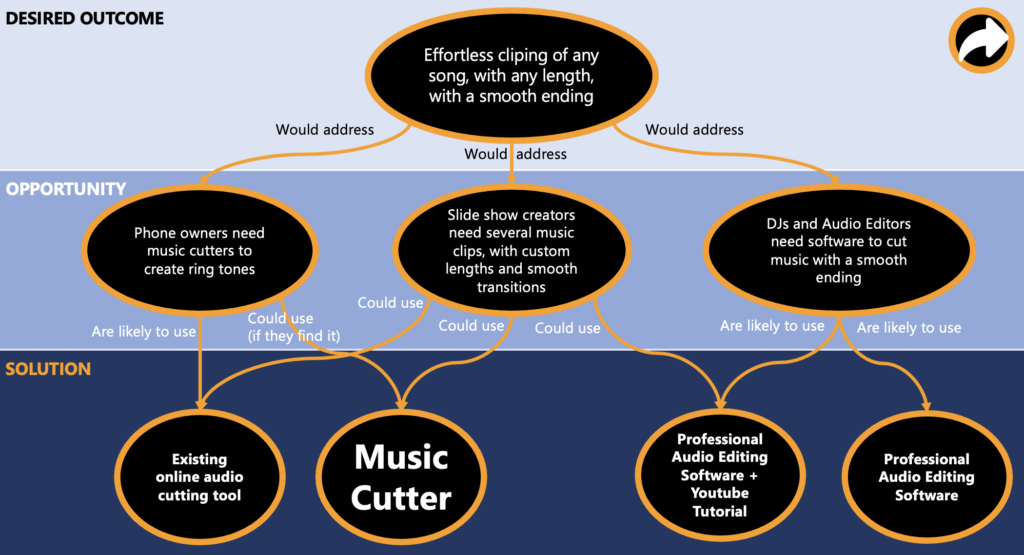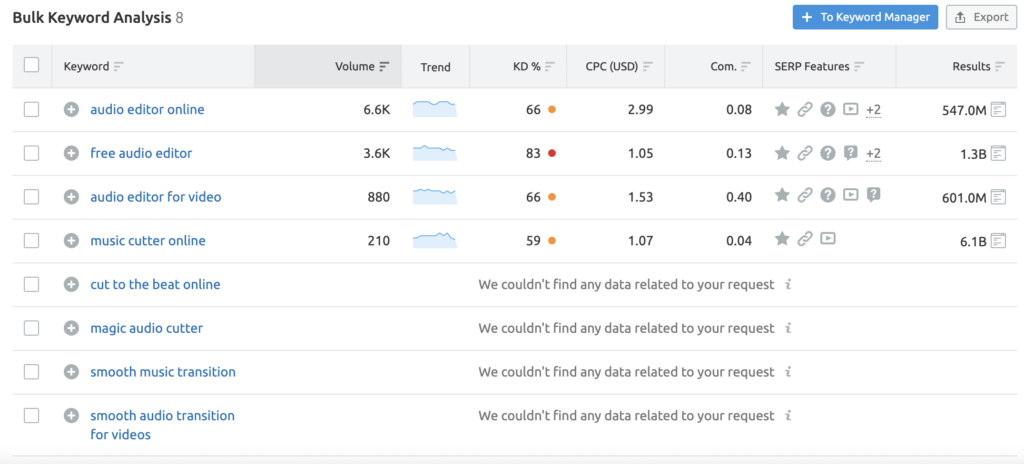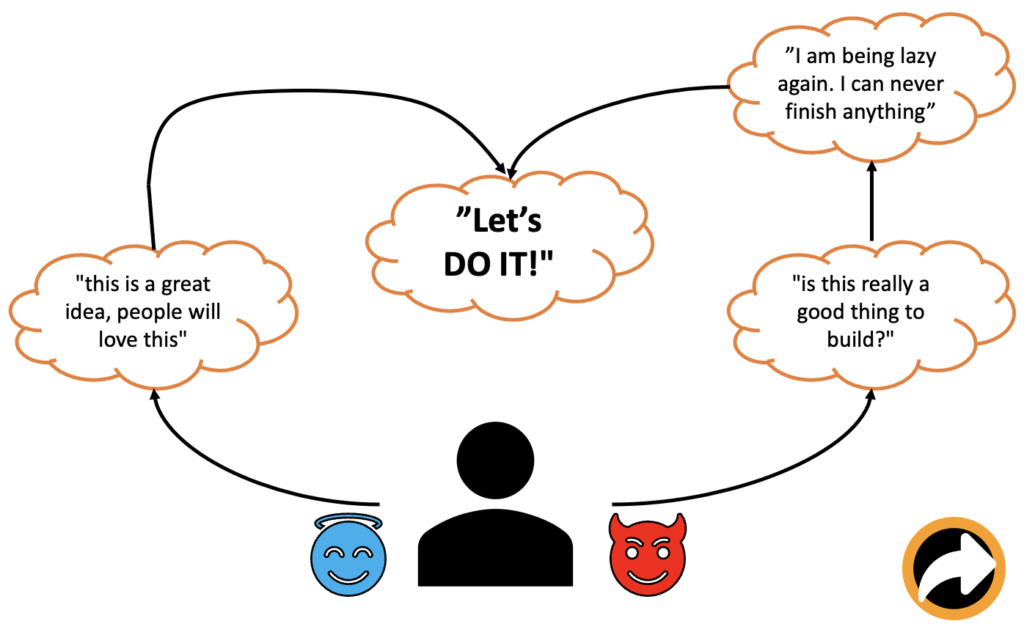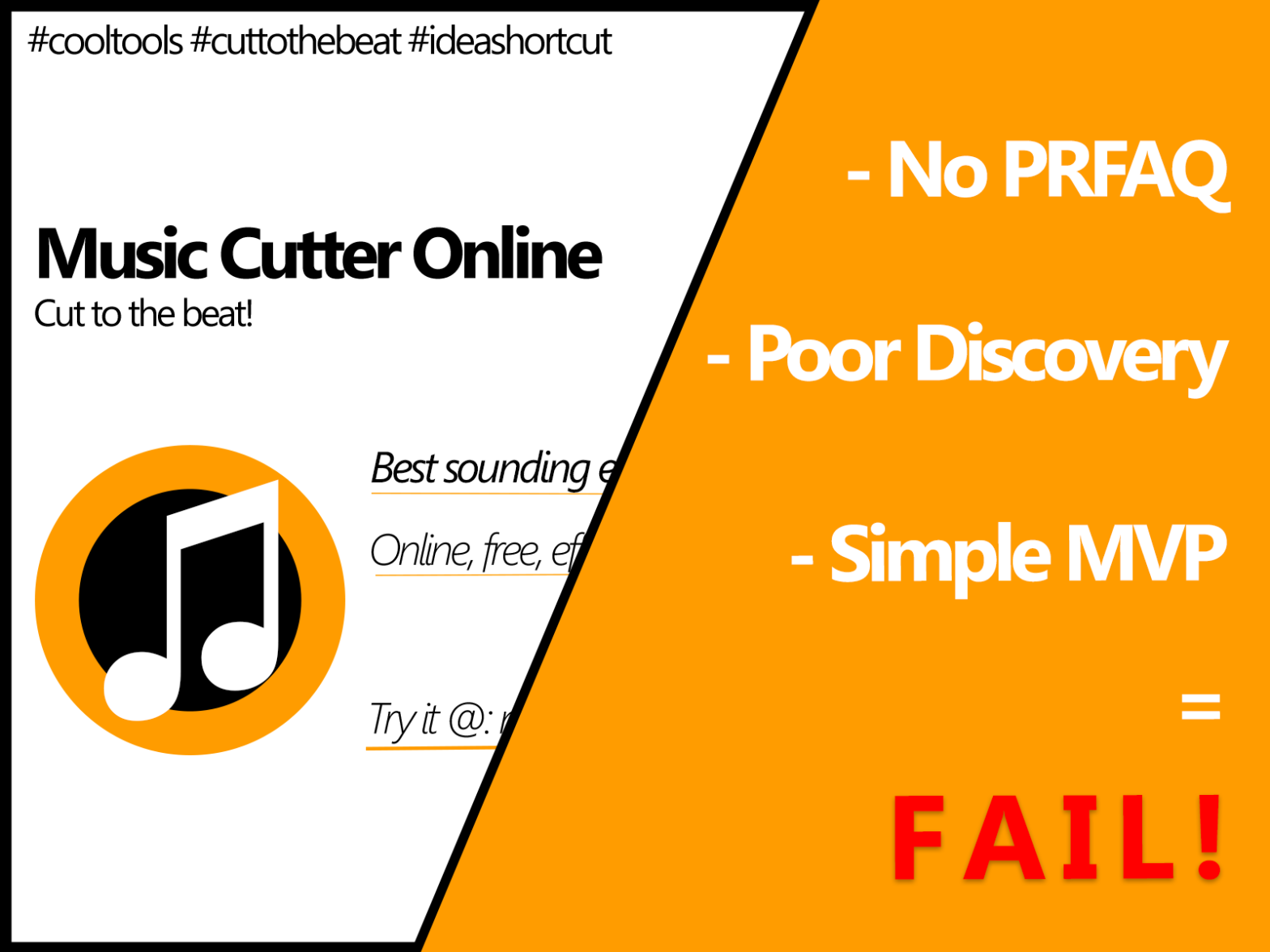On this week’s post we will do the post mortem and review the anatomy of a failed product. We will look back at the Idea Shortcut’s first project: Music Cutter and uncover why it has not taken off.
The Idea and its faults
What’s the idea?
Music Cutter Online – Cut to Beat is a free online editing web app that makes it easy for content creators to get the best sounding endings for their clips, consistently and effort free.
This tool allows users to cut audio clips of almost any audio format (MP3, AAC, FLAC, WAV, etc.) in 4 easy steps:
- Upload
- Slice or Cut to the beat
- Apply Effects
- Download
This web app has a proprietary audio processing “Cut to the Beat” algorithm that processes the best sounding points to end the clip.
How did I get the idea?
On my wife’s 30th anniversary I decided to make her a video with flash backs of her life, from the time she was little to the present day. The music I used in the video had to fit the duration of a photo slide show.
I am not an expert in both audio and video editing, so cutting a song and making the end sound good was a challenge. When I cut the audio track arbitrarily I was not be able to make a smooth transition to the next song. Not only I did not know how to make the ending of the song sound well, but also did not know how to use the software to achieve it. At this point I thought “Could this be an opportunity?”.
Any initial indication that there was something wrong with the idea?
One of the things that stroke me at the time was that the idea was really hard to explain to someone that had not experienced the problem. This could have been an early indicator that my product market fit would be flawed.
I was developing an idea targeted to casual video editors. These users would not be editing regularly, nor would be able to dedicate a lot of time to understand how music cutter would help them with the audio editing part of the process. My expected user journey, based on my own experience with my wife’s video, was to basically google “best sounding music cuts” and get a software that did exactly what I needed. If it was to explain to a non-expert user how music cutter would be able to help, it is likely that once this user faced the necessity, either he would not be able to know what to search for to find music cutter, or he would not be able to understand that music cutter would solve his/her problem.
What did I do and should have done after I got the idea?
I focused on competitor products: “is there anything online that does this?”. Note that was not exactly exploring the competition. I did not consider all the possible solutions that could tackle the problem. I basically looked for a product that would basically be the solution that I envisioned. As I could not find an exact match I thought: “There is nothing out there exactly like music cutter. This should not take much time, I will just build it!”.
Instead of diving head first into an half baked solution, to a half baked problem statement, I should have done some product discovery.
Product Discovery
A good exercise that I could have done before stepping straight into building the product, was to build an opportunity solution tree. We talked briefly about how opportunity solution trees could help product managers work backwards: checkout Product Discovery – 13 important PFRAQ questions to ask.

Desired Outcome
The desire outcome is the root of the tree and should reflect the value that we are trying to drive. In this case, what users (like me) would like to achieve: Effortless clipping of any song, with any length, with a smooth ending.
Opportunity
Even though the opportunity that I was facing when creating my wife’s video was very specific, the desired outcome above would tackle more than one problem. If a user is looking to create a ringtone he/she would be also looking for something that could deliver effortless song clipping at any length (the user would probably not care that much about the ending though). Similarly, DJs and Audio Editors, could also be looking for similar outcomes.
Solution
There are multiple solutions to tackle the opportunities described. One of them could actually be music cutter, the fit may not necessarily the best for all opportunities though.
Phone owners looking to create ringtones would probably look for the first free software that they can find on a google search. They do not necessarily care that much about smooth endings. They could use Music Cutter, if it was first on Google Search, but even so, it probably has more features than they care about.
DJs, Audio Editors or Professional Video Editors would be more likely to use professional editing software to run their audio edits. Being effortless is not a core need for them. Being easy to use is a plus, but what they care about the most is to have flexibility to tweak the audio and the ending.
Slideshow and amateur video editors that need music clips with custom lengths and smooth transitions would be the best fit for music cutter. Still, other solutions could also fit the opportunity like:
- Existing online audio editing software – if they can spend some time to find a good moment to cut the song, or if they are willing to simply use the whole song
- Professional audio editing software + Youtube Tutorial – Nowadays you can easily learn how to use professional software with the help of a few youtube videos. If the user was willing to spend some time he/she could still get the job done. This was what I resorted to when I faced the problem.
Assumption Testing
There is a link between the opportunity and our solution. However we can not establish if music cutter would be successful at this point. There are a number of hypothesis that would need to be validated:
- Users will be able to find Music Cutter Online
- Our target audience is monetizable
- Our target audience will use Music Cutter in detriment of other existing solutions
- Our proposed feature set caters to the need of our target audience
We will reflect on some of these hypothesis by looking at some PRFAQ questions that would have highlighted Music Cutter’s challenges.
PRFAQ
PRFAQs are great ways to review the aspects that can make products successful. They force you to work backwards from the user’s perspective and understand the characteristics of the personas, the key drivers for adoption and the possible alternatives users have at their disposal. Beyond that it should help derive the market size and product market fit.
We have developed a couple tools to help building PRFAQs. Check them out:
The questions below were extracted directly from the (PR)FAQ Database.
17708. How many consumers/organizations (B2C/B2B) have the characteristics/capabilities/constraints necessary to make use of the product?
It is all well and good that there is an opportunity-solution pair, but how many users would actually have this need? For the users that have this need, would music cutter have all the attributes required to cater for the need.
A possible way to address this question is to look at user acquisition. As mentioned before, the expected user journey for music cutter was for users to find it through google search. Assuming these users are out there are already using search for such solution, we can do some SEO keyword analysis to measure the population size:

The table above paints a great picture. We can see that semrush only has data for the most generic searches like “audio editor online”, or “music cutter online”. For these, the combined number of searches is 10K/month on Google US. If we translated this to the number of visits (assuming we would be the destination for them all) the number is small. This is especially true if we wanted to keep music cutter as a free to use tool. 10K users would not be enough to monetise the site. At a 1$ CPM, we would be looking at 10$/month revenue.
The other interesting insights are around the competition for the keywords. The Keyword Difficulty (KD), which measures how difficult it is to rank high with a given keyword is always above 59%. This means the content would have to be amazing to be able to rank above the rest. This insight is backed by the cost of acquisition of using Google Ads (CPC). At 1-3$ a click, the cost is 1000-3000x higher then the return we would get for each visit. To close the analysis, we can also see that there are billions of addresses available for each search, between software, tutorials, FAQs and video courses.
Bottom line, the answer to the question: “How many consumers/organizations (B2C/B2B) have the characteristics/capabilities/constraints necessary to make use of the product?” is “Probably not enough”.
25630. How do you know what customers need or want?
Instinct? We purely relied on instinct and past experience, which was only valid for me as a user.
We have not done any assumption testing. There were a number of hypothesis that needed to be validated, as we have seen in discovery exercise. Nevertheless, when we developed the MVP we have not really thought much about validating them.
We have already seen that there were alternative solutions to the opportunity, Youtube Tutorials and other general purpose audio cutting tools, for example. These would definitely be things to benchmark against. The main KPI to look for in the competition was around user acquisition. In this case, SEO rank would perhaps be a good indicator.
Learnings
On the post mortem of the project I put some thought on understanding what I have learned with the project and what prompt me to make mistakes. Lets start with the latter.
The Desert Crossing Paradox
People are naturally lazy, not everybody is willing to put in the effort to cross the desert. This is such a common place, that the reader has probably already seen some form of motivational content that focus on action. The messaging on this content usually supports a “just do it” mentality, instead of focusing on planning and strategy. Unfortunately, success is not always about doing, it is also about doing the right things.
As a product manager, “doing the right things” is and should always have been a standard practice mentality for me. However, when it comes to life outside work, especially in long projects that require a big deal of personal effort, the judgment becomes cloudier.
I have a tendency to get excited quickly when I have an idea. It is relatively easy for me to get started and get some steps done. However, I also have a big track record of leaving projects unfinished. Combined, these 2 mindsets can form a fallacious mental cocktail.

The figure above demonstrates the thoughts I had during the build of music cutter. I wondered between “this is a great idea, people will love this” and “is this really a good thing to build?”. The latter would be a good way to reveal product market fit issues. However, my natural reaction was to think that my doubts about the product were just my brain coming up with excuses. I have a track record of not being able to cross the deserts. After years of leaving projects unfinished, the distinction between “I haven’t thought this through” and “I am being lazy” becomes fuzzy. Even product managers fall into build traps and my previous challenges in getting projects done was one of the main drivers that led me into it.
Positive notes on the MVP
The best outcome of music cutter was that we were actually able to create a project that solved the problem statement effectively, at least for the user that came up with it. We were are also able to do it in 35-50 hours of work in total and spending just a few pennies on hosting.
Bottom line, we have not developed a successful product, but we failed fast and spent close to nothing.
Technical Skills and Code Constructs
Other interesting outcomes were on the technical learnings we made around developing the solution. We learned about music theory, audio processing algorithms, React and WordPress. Additionally, we were also able to re-use some of the code in other projects like the Press Release Generator.
The Future of Music Cutter
After the description above does this mean that we will close music-cutter.online? The answer is no. Currently the product has 0 investment. We will not develop any new features unless we get users on it.
After all the considerations above about the opportunity and product market fit may change in the future. We may get feedback to guide us in a different direction and allow us to pivot to another solution. Maybe we can even find another opportunity that can be covered by a solution similar to what we have in music-cutter.online. Plus, since I created the product to cater for my personal need, music-cutter will always have at least one user.
